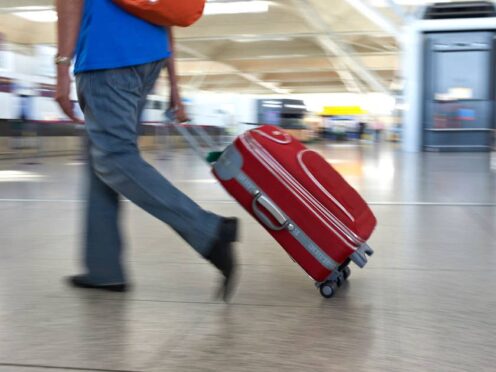
A planned relaxation of rules around airline passengers carrying liquids in hand luggage has been delayed by a year.
The Government announced it has granted extensions to several large UK airports unable to meet its June 1 deadline to fully install new scanning technology.
The new scanners produce more detailed images, meaning passengers can be allowed to pass through airport security with containers holding up to two litres of liquid in their hand luggage.
At airports which have not put them in place, the limit remains 100ml and containers must be put in clear plastic bags.
The new scanners also end the need for laptops and tablets to be removed from hand luggage.
A deadline of December 2022 for most major airports to deploy new scanners was initially set in August 2019 by then-prime minister Boris Johnson.
After the aviation industry suffered huge disruption due to coronavirus travel restrictions, in December 2022, Transport Secretary Mark Harper set a new date of June 1 2024.
He said at the time this would reduce queuing times.
Many airports are struggling to install the scanners ahead of the busy summer holiday period, largely due to supply chain delays and construction difficulties caused by the weight of the machines.
Ministers have issued extensions of up to 12 months to several airports on a case by case basis, which is expected to be enough time for them all to complete the work.
The Government is also exploring how financial penalties could be imposed for further non-compliance.
The Department for Transport refused to provide a breakdown of the situation for each airport, citing security concerns.
It said by the start of June about half of passengers flying from UK airports will be processed by the new scanners.
But passengers are advised to prepare to follow the existing rules, and check with their airport for any changes.
Mr Harper said: “These cutting-edge scanners will make air travel safer and easier for passengers by strengthening security even further.
“The UK is leading the world with its rollout of this technology, but it’s important we give those airports yet to meet the deadline a second chance to get the job done.
“Until they do, passengers should continue to check before travelling.”
Heathrow has previously said it expects to have new scanners in all security lanes this summer, while Gatwick expects to complete the programme by the end of March next year.
Manchester Airports Group, which runs Manchester, East Midlands and Stansted airports, said its scanners will be fully rolled out in 2025.
London City become the UK’s first major airport to begin using the new scanners for all passengers in April last year.
Karen Dee, chief executive of trade body the Airport Operators Association, said: “Airports are making excellent progress in delivering these multi-million-pound investment programmes, which will ensure the UK remains at the forefront of aviation security in the years ahead.
“As with any programme of this complexity, there are significant challenges, and we are happy the Government has recognised these and agreed to extend timeframes for delivery where necessary.
“By adopting this approach, airports can ensure that they are ready to welcome passengers over the upcoming holiday periods and that their journeys are safe, secure and smooth as we make this transition.”
Naomi Leach, deputy editor of Which? Travel, said: “Passengers should have been looking forward to a more efficient security process at the UK’s biggest airports this summer. Instead, with different rules and processes now likely to apply at different airports, the ensuing confusion could lead to further delays.
“It’s imperative that these changes are made as quickly as possible and that the rules at different airports are communicated clearly to passengers in the meantime. Those airports that have failed to install the scanners in time should not increase passenger fees this year – this would be impossible to justify when this key improvement to the passenger experience has not been made.”
Airport security restrictions for liquids were introduced in 2006 following a foiled terror plot to blow up planes flying from London to the US with homemade liquid bombs.
Travellers failing to adhere to them is one of the biggest causes of delays at airport security checks.

Enjoy the convenience of having The Sunday Post delivered as a digital ePaper straight to your smartphone, tablet or computer.
Subscribe for only £5.49 a month and enjoy all the benefits of the printed paper as a digital replica.
Subscribe